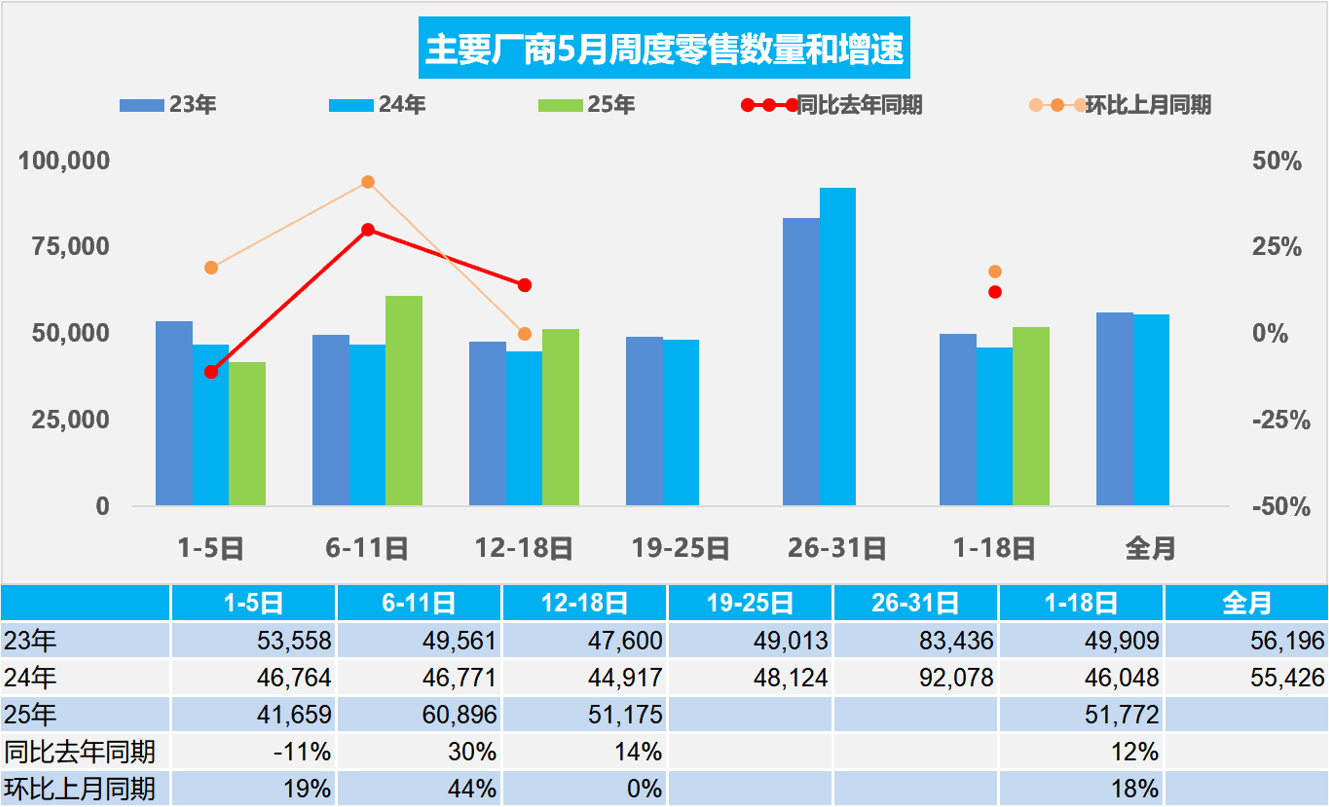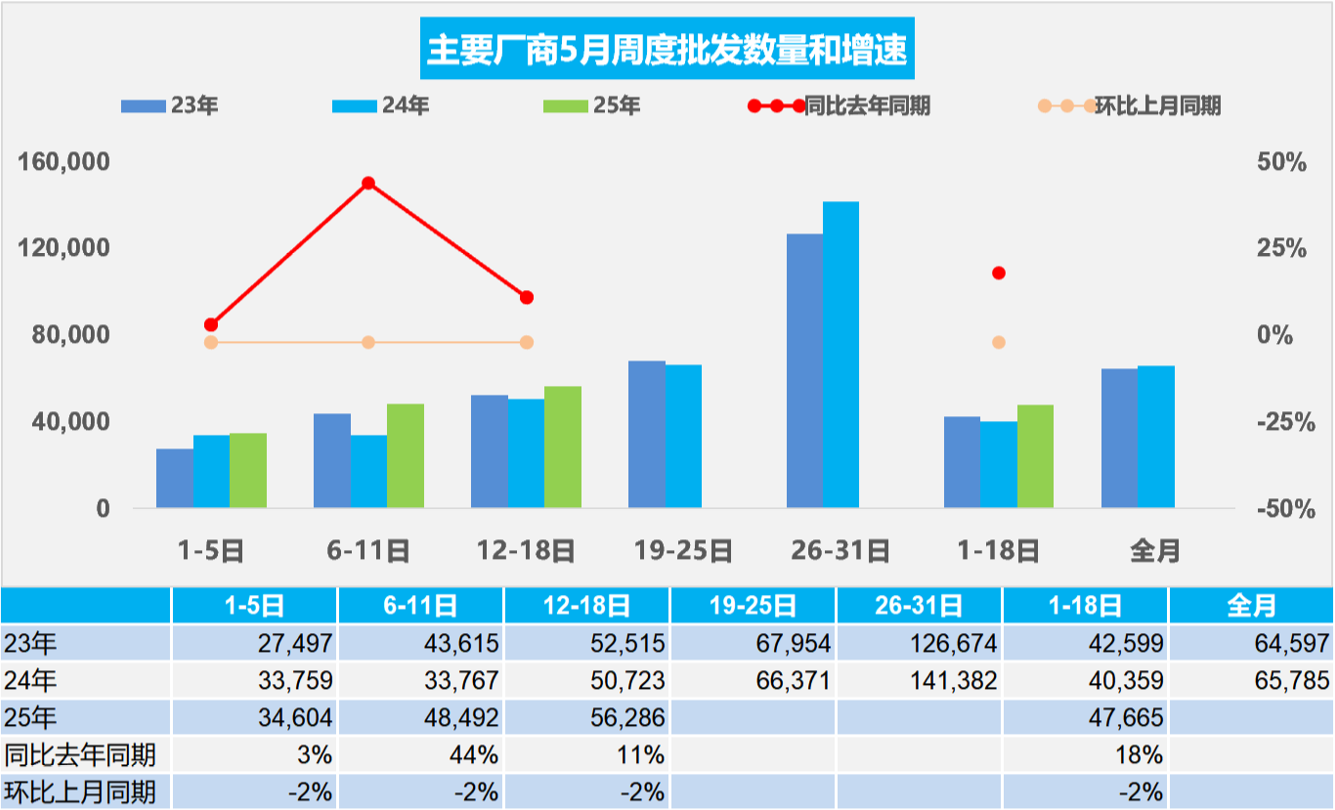Passenger Link Branch: Retail sales of 932,000 vehicles in the national passenger car market increased 12% year-on-year from May 1-18
The Zhitong Finance App learned that from May 1-18, the passenger car market retailed 932,000 vehicles, up 12% from the same period in May last year and 18% over the same period last month. Since this year, 7.804 million vehicles have been retailed, up 8% year on year; the retail trend in the passenger car market continued to maintain a steady and positive trend in May.
From May 1 to 18, passenger car manufacturers across the country wholesale 858,000 vehicles, an increase of 18% over the same period in May last year, and a decrease of 2% from the same period last month. Since this year, 9.326 million vehicles have been sold, an increase of 12% over the previous year.
In terms of new energy, the national passenger car NEV market retailed 484,000 vehicles from May 1 to 18, an increase of 32% over the same period of May last year, an increase of 15% over the same period last month. The retail penetration rate of the national NEV market was 52%. Since this year, 3.808 million vehicles have been retailed, an increase of 35% over the previous year.
From May 1 to 18, passenger car manufacturers across the country wholesale 467,000 new energy vehicles, an increase of 23% over the same period in May last year, an increase of 0% over the same period last month, and the wholesale penetration rate of new energy manufacturers was 54.4%. Since this year, 4.448 million vehicles have been sold, an increase of 40% over the previous year.
In 2025, retail sales in the national passenger car market will be stable

In the first week of May, the national passenger car market sold an average of 42,000 vehicles per day, down 11% from the same period in May last year, and up 19% from the same period last month.
In the second week of May, the national passenger car market sold an average of 61,000 vehicles per day, up 30% from the same period in May last year and 44% from the same period last month.
In the third week of May, the national passenger car market sold an average of 51,000 vehicles per day, up 14% from the same period in May last year, and 0% higher than the same period last month.
From May 1 to 18, the national passenger car market retailed 932,000 vehicles, up 12% from the same period in May last year, up 18% from the same period last month; since this year, 7.804 million vehicles have been sold, up 8% year on year.
Under the joint promotion of national consumption promotion and local policies corresponding to many provinces and cities, offline events at the Spring Auto Show will fully invigorate the market atmosphere and gather popularity at an accelerated pace. New product launches in April were extremely active, and a series of promotions continued, such as the manufacturer's “one price” strategy and “zero interest” car purchase finance plan. The recent promotion of intelligent terminal assisted driving has had an average effect on sales. In order to seize the opportunities of the trade-in policy, many companies have introduced replacement and scrapping subsidies on the manufacturer side, which are quite effective.
In May 2025, the wholesale sales volume of passenger car manufacturers across the country was stable

In the first week of May, passenger car manufacturers across the country sold an average of 35,000 vehicles per day, an increase of 3% over the same period in May last year, and a decrease of 2% over the same period last month.
In the second week of May, the average wholesale volume of passenger car manufacturers nationwide was 48,000 vehicles per day, up 44% from the same period in May last year, and down 2% from the same period last month.
In the third week of May, the average wholesale volume of passenger car manufacturers nationwide was 56,000 vehicles per day, up 11% from the same period in May last year, and down 2% from the same period last month.
From May 1 to 18, passenger car manufacturers across the country wholesale 858,000 vehicles, an increase of 18% over the same period in May last year, and a decrease of 2% from the same period last month; since this year, 9.326 million vehicles have been sold, an increase of 12% over the previous year.
Due to drastic changes in the external environment and huge external change pressure that exceeds expectations, the actual drastic increase in tariffs has had an impact on passenger car market sales in Jiangsu and Zhejiang that is significantly lower than the growth rate in other regions. However, the country has long had a policy orientation to promote domestic demand, so the trend of development being driven together by “internal and external demand” is becoming more and more obvious. In recent months, automakers have increased inventories and stabilized sales, and the effects of stabilizing domestic demand in the passenger car industry have continued to be reflected.
 Wall Street Journal
Wall Street Journal